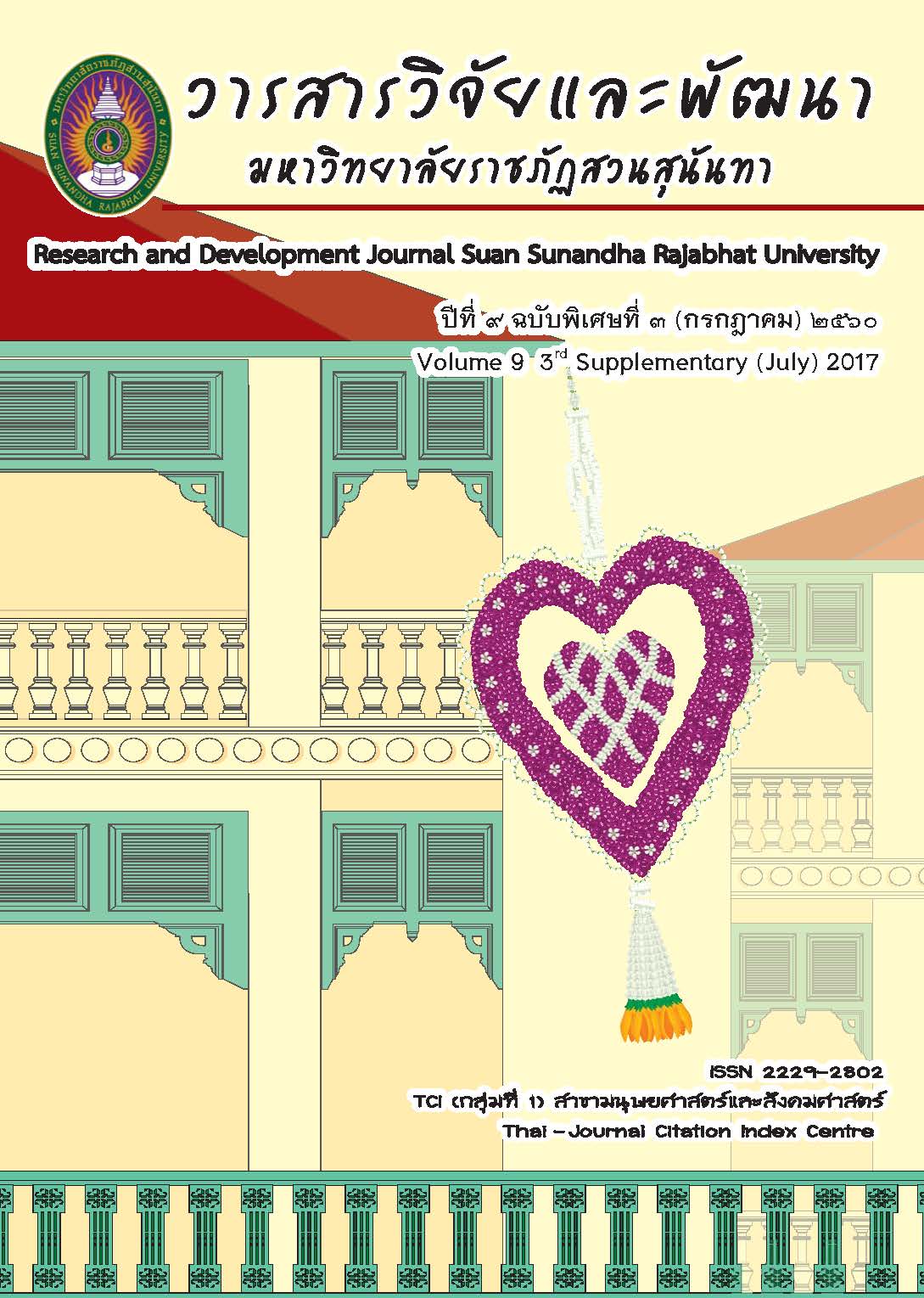การใช้นาฏยประดิษฐ์ ชุดพฤกษศาสตร์โรงเรียน เพื่อพัฒนาความคิดสร้างสรรค์ ของเยาวชน กรณีศึกษาโรงเรียนบดินทรเดชา (สิงห์ สิงหเสนี)
DOI:
https://doi.org/10.53848/irdssru.v9i3%20SUP.214294คำสำคัญ:
นาฏยประดิษฐ์, พฤกษศาสตร์โรงเรียน, พัฒนาความคิดสร้างสรรค์บทคัดย่อ
การวิจัยครั้งนี้ มีวัตถุประสงค์ เพื่อศึกษาผลของการใช้นาฏยประดิษฐ์ ชุดพฤกษศาสตร์โรงเรียน
เพื่อพัฒนาความคิดสร้างสรรค์ของเยาวชน กลุ่มตัวอย่างที่ใช้ในการวิจัยครั้งนี้เป็นเยาวชนที่กาลังศึกษา
อยู่ในระดับชั้นมัธยมศึกษาปีที่ 2/3 จานวน 34 คนภาคเรียนที่ 2 ปีการศึกษา 2559 โรงเรียนบดินทรเดชา
(สิงห์ สิงหเสนี) จานวน 1 ห้องเรียน ที่ได้มาจากการเลือกกลุ่มตัวอย่างแบบแบ่งกลุ่ม (Cluster Random
Sampling) โดยใช้ห้องเรียนเป็นหน่วยการสุ่ม โดยใช้กิจกรรมนาฏย-ประดิษฐ์บูรณาการร่วมกับเรื่อง
พฤกษศาสตร์โรงเรียน เครื่องมือที่ใช้ในการวิจัย คือ 1) แผนการจัดการเรียนรู้กิจกรรมนาฏย-ประดิษฐ์
2) แบบวัดความคิดสร้างสรรค์ 3) แบบประเมินความคิดสร้างสรรค์ผ่านการแสดงนาฏยประดิษฐ์ สถิติที่
ใช้ในการวิจัยครั้งนี้ ประกอบด้วยค่าความถี่ ค่าร้อยละ ค่าเฉลี่ย ส่วนเบี่ยงเบนมาตรฐาน การทดสอบค่าที
(t-test) และการวิเคราะห์เนื้อหา (Content Analysis)
ผลการวิจัย พบว่า เยาวชนที่ได้เรียนรู้การใช้นาฏยประดิษฐ์ ชุดพฤกษศาสตร์โรงเรียนก่อน และ
หลังการใช้กิจกรรมนาฏยประดิษฐ์ มีการพัฒนาความคิดสร้างสรรค์ ในภาพรวม ที่แตกต่างกัน อย่างมี
นัยสาคัญทางสถิติที่ระดับ .01 และพบว่า เยาวชนมีการพัฒนาความคิดสร้างสรรค์ ในการสร้างสรรค์
ผลงานการแสดงนาฏยประดิษฐ์ ชุดพฤกษศาสตร์โรงเรียนในภาพรวมที่แตกต่างกัน อย่างมีนัยสาคัญ
ทางสถิติที่ระดับ .001
เอกสารอ้างอิง
Development and Language
Deverlopment” . Education
Psychology. New York: Randomhouse.
Department of Curriculum and Instruction
Development. (1992). Creativitytheories-
instructions-assessment
and evaluation. Bangkok: Ministry
of Education.
Department of Curriculum and Instruction
Development. (1999). The synthetic
form of development of
children’s cognitive skills in
Thailand. Bangkok: Religious
Affairs.
Gale, R.F. (1961). Developmental Behavior :
A Humanistic Approach. New York
: The Macmillam, 1960.
Horkuraruk, A. (2007). Education for
sustainable development in Thai
context. Bangkok: Thailand
Environment Institute.
Kittisaknawin, C. (2009). Trust in
organizations of Thailand:
Comparative study between
government and private
organization. (Doctoral dissertation)
Ramkhamhaeng University, Thailand.
Lipananon, J. (1996). Using a series of
training activities for teachers
dance with grade 4 (Master’s
thesis). Cahiang Mai University,
Thailand.
Malakul, P. (2002). Talent development.
(2nd ed.). Bangkok: Chulalongkorn
University.
Ministry of Education. (2009). The dasic
education core curriculum B.E.
2551 (A.D. 2008). Bangkok: The
Agricultural Co-operative Federation of
Thailand., LTD.
Ministry of Education. (2011). Quality
Assurance in Education. Bangkok:
Kurusapa Ladprao Printing Press.
Moonkham, S., & Moonkham, O. (2001).
Learning management: Creative
thinking development. (5th ed.)
Bangkok: Parbpim.
Petsri, W. (2009). The development of
an instructional model of dramatic
arts to enhance creative thinking
for primary level 2 students.
(Doctoral dissertation). Burapha
University, Thailand.
Praditsuktaworn, P. (n.d.). Arts. Retrieved
April 4, 2015, from http://taamkru.
com/th.
Ritruechai, O. (n.d.). The development
of creative intelligence. Retrieved
April 4, 2015, from edoffice.
kku.ac.th.
Torrance, E.P. (1965). Rewarding Creative
Behavior: Experiments in
Classroom Creativity.
Vessawasdi, P. (2004). Effects of
organizing movement and
rhythmic activities using creative
dance approach on kindergarteners’
creativity. (Master’s thesis).
Chulalongkorn University.
Wasi, P. (1998). Eaucation reform:
Intellectual enhancement for
survival. Bangkok: Sodsrisaritwong
Foundtion.
ดาวน์โหลด
เผยแพร่แล้ว
รูปแบบการอ้างอิง
ฉบับ
ประเภทบทความ
สัญญาอนุญาต
บทความที่ได้รับการตีพิมพ์เป็นลิขสิทธิ์ของ สถาบันวิจัยและพัฒนา มหาวิทยาลัยราชภัฎสวนสุนันทา
ข้อความที่ปรากฏในบทความแต่ละเรื่องในวารสารวิชาการเล่มนี้เป็นความคิดเห็นส่วนตัวของผู้เขียนแต่ละท่านไม่เกี่ยวข้องกับมหาวิทยาลัยราชภัฎสวนสุนันทา และคณาจารย์ท่านอื่นๆในมหาวิทยาลัยฯ แต่อย่างใด ความรับผิดชอบองค์ประกอบทั้งหมดของบทความแต่ละเรื่องเป็นของผู้เขียนแต่ละท่าน หากมีความผิดพลาดใดๆ ผู้เขียนแต่ละท่านจะรับผิดชอบบทความของตนเองแต่ผู้เดียว





